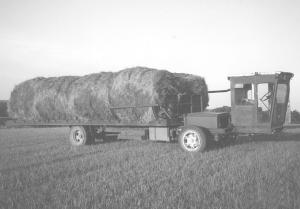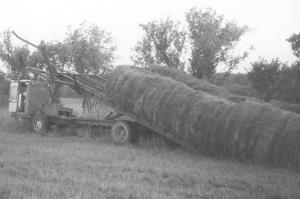1999 - Volume #23, Issue #2, Page #31
[ Sample Stories From This Issue | List of All Stories In This Issue | Print this story
| Read this issue]
Round Bale Hauler Built From 2-Ton Truck Frame, Combine Cab
 |
 |
"It's not as fancy as the commercial models but it does the job. My total cost, not including labor, was only about $5,000," says Ballard.
The rig is equipped with a loading arm that picks up bales on-the-go. It'll carry up to 10 round bales at a time at highway speeds.
He stripped the mid 1960's IH truck down to the frame and fitted it with a 283 cu. in. gas engine. He used 8-in. channel iron to build a frame for the engine and welded it to the front part of the truck frame. He kept the car's 3-speed automatic transmission and attached a transfer case to it. A hydraulic pump that's belt-driven off the engine crankshaft is used to operate the bale hauler.
The 23-ft. long deck is 9 ft. wide and has parallel pipes welded lengthwise onto the frame. The operator approaches each bale so that its end fits into the open end of the loader arm. A pair of hydraulic cylinders swings the bale up onto the bed. A hinged pipe then kicks the bale over to the opposite side. A second bale is lifted onto the bed alongside the first one. A hydraulically-operated pusher plate then pushes both bales back 6 ft. on the bed. The process is repeated until the bed is loaded.
The pusher plate is returned automatically by a hydraulic motor.
To unload bales, the operator hydraulically tilts the bed until the back end touches the ground and then pushes the bales off as the truck moves ahead.
"When bales are unloaded they stay in a nice neat stack," says Ballard. "A steel divider at the back of the deck keeps the two rows of bales about 1 ft. apart as they're unloaded. Normally the bales are unloaded tight against each other end to end. However, if I don't ride the brake as I go forward during unloading I can space the bales about 1 ft. apart.
"Because of the transfer case and 2-speed rear axle it has a lot of power in the field. I keep the transfer case in low so the engine doesn't have to work hard. However, it could use a little more power on the highway, especially when going up hills. I mounted dual glasspack mufflers on it to increase exhaust flow and performance.
"I made linkages that connect the combine controls to hydraulic valves that mounts behind the cab so I can use the combine's original control levers for all operations."
Contact: FARM SHOW Followup, Roy A. Ballard, Rt. 2, Box 611, Madison, Kan. 66860 (ph 316 427-4111).

Click here to download page story appeared in.

Click here to read entire issue
To read the rest of this story, download this issue below or click here to register with your account number.




